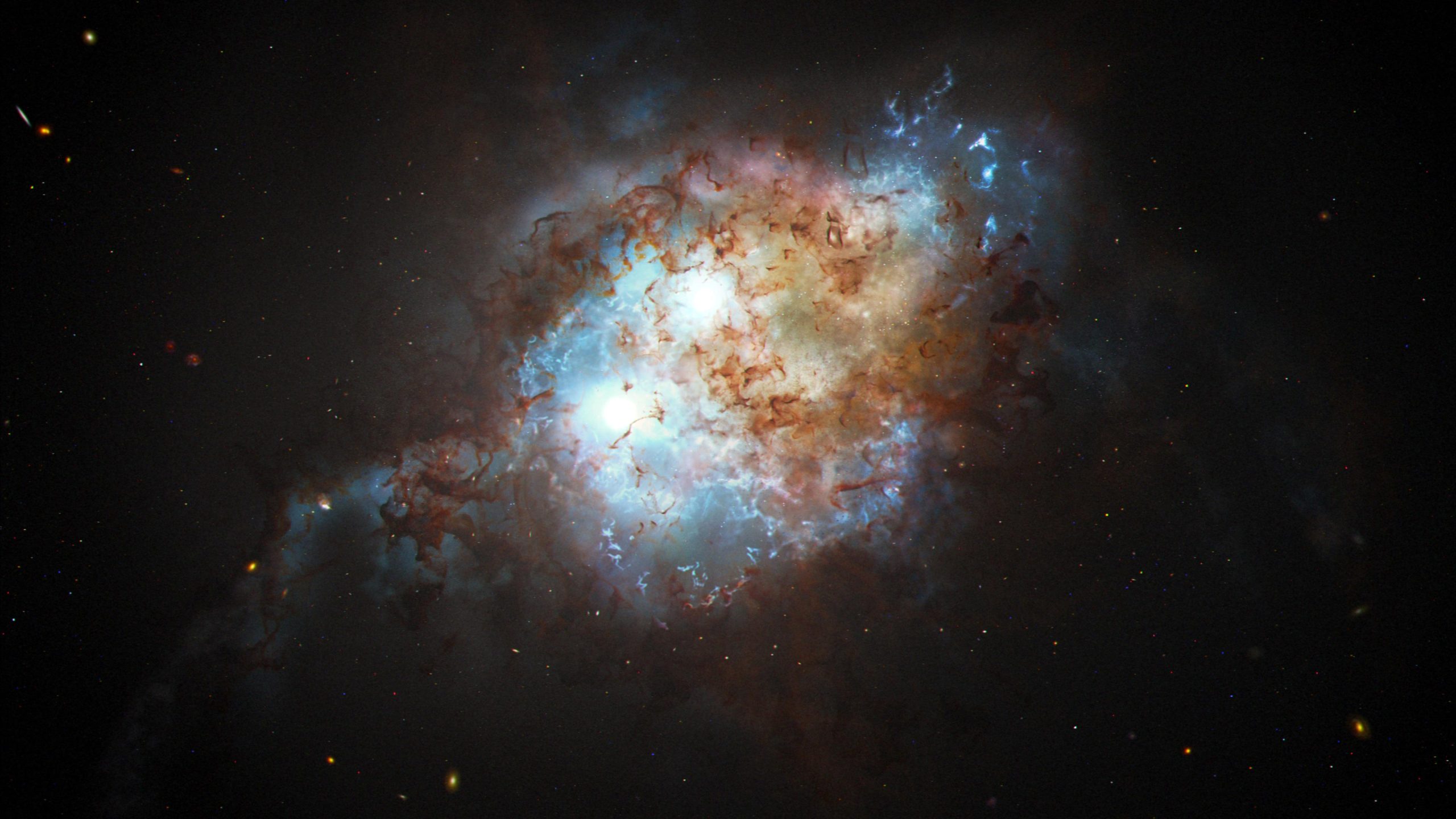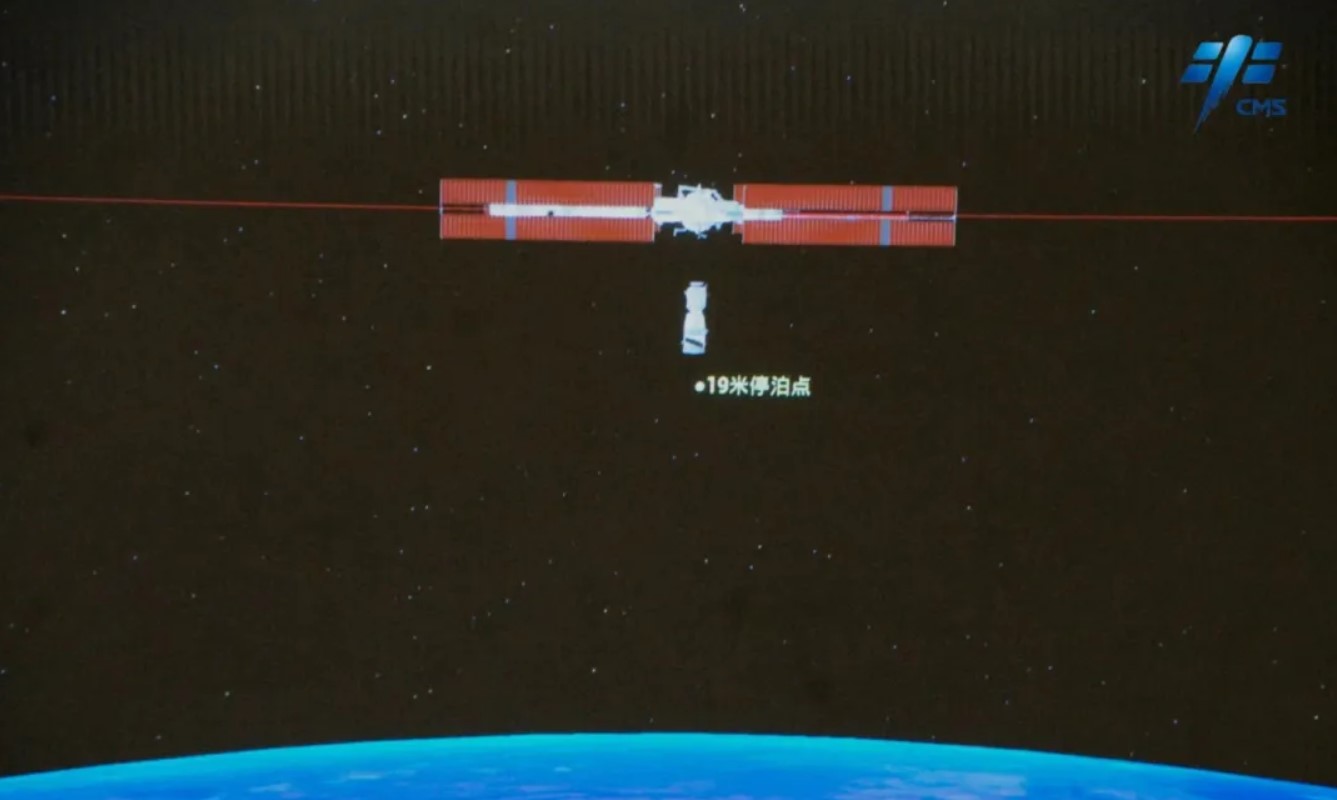
El concepto de este artista muestra el resplandor espectacular de dos cuásares que residen en los centros de dos galaxias que se encuentran en el caótico proceso de fusión. La atracción gravitatoria entre dos galaxias enciende la tormenta de fuego del nacimiento de estrellas. Los cuásares son faros brillantes de luz intensa desde los centros de galaxias distantes. Están alimentados por agujeros negros supermasivos que se alimentan de materia que cae. Este frenesí de alimentación desencadena una corriente de radiación que puede eclipsar la luz colectiva de los miles de millones de estrellas de la galaxia anfitriona. Durante unos miles de millones de años, los agujeros negros y sus galaxias se fusionarán para formar un par de cuásares, un agujero negro aún más grande. Crédito: NASA, ESA, Joseph Olmsted (STScI)
Un par de galaxias fusionadas encienden agujeros negros en curso de colisión
Los cuásares se encuentran entre los fuegos artificiales más brillantes del universo. Dispersos por el cielo, arden con la riqueza de más de 100 mil millones de estrellas. Y, como una brillante bengala aérea del 4 de julio, son deslumbrantes durante un tiempo relativamente corto, en escalas de tiempo cósmicas. Esto se debe a que están alimentados por agujeros negros supermasivos turbulentos que ingieren grandes cantidades de gas y polvo que se calientan a altas temperaturas. Pero el buffet de comida cuásar solo dura un tiempo.
Esta propiedad rápida de los cuásares ha permitido a los astrónomos detectar dos cuásares que chocan entre sí. Están incrustados en un par de galaxias que chocaron hace 10 mil millones de años. Tales gemelos energéticos son raros en el universo distante. Los hallazgos proporcionan pistas sobre cuán inestable era el universo hace mucho tiempo, cuando las galaxias chocaban con frecuencia y los agujeros negros se envolvían en restos flotantes y desechos de encuentros cercanos.
Como los dos cuásares brillan a diferentes velocidades a medida que aumenta y disminuye su combustible, se identificaron como un proceso inusual en el espacio. Hubble se acercó y resolvió claramente el par y sus galaxias anfitrionas.

Foto del telescopio espacial Hubble de un par de cuásares de cuando el universo tenía solo 3 mil millones de años. Están incrustados dentro de un par de galaxias en colisión. Los cuásares están separados por menos de un tamaño galáctico. Los cuásares están alimentados por agujeros negros turbulentos y supermasivos que lanzan feroces fuentes de energía cuando se involucran en gas, polvo y cualquier otra cosa que esté bajo su control gravitatorio. Los agujeros negros eventualmente se fusionan. Crédito: NASA, ESA, Yu-Ching Chen (UIUC), Hsiang-Chih Hwang (IAS), Nadia Zakamska (JHU), Yue Shen (UIUC)
El telescopio espacial Hubble descubrió inesperadamente un cuásar gemelo en el universo distante
El universo primitivo era un lugar agitado donde las galaxias a menudo chocaban y se fusionaban. Usando[{» attribute=»»>NASA’s Hubble Space Telescope and other space and ground-based observatories, astronomers investigating these developments have made an unexpected and rare discovery: a pair of gravitationally bound quasars, both blazing away inside two merging galaxies. They existed when the universe was just 3 billion years old.
Quasars are bright objects powered by voracious, supermassive black holes blasting out ferocious fountains of energy as they engorge themselves on gas, dust, and anything else within their gravitational grasp.
“We don’t see a lot of double quasars at this early time in the universe. And that’s why this discovery is so exciting,” said graduate student Yu-Ching Chen of the University of Illinois at Urbana-Champaign, lead author of this study.
Finding close binary quasars is a relatively new area of research that has just developed in the past 10 to 15 years. Today’s powerful new observatories have allowed astronomers to identify instances where two quasars are active at the same time and are close enough that they will eventually merge.
There is increasing evidence that large galaxies are built up through mergers. Smaller systems come together to form bigger systems and ever larger structures. During that process there should be pairs of supermassive black holes formed within the merging galaxies. “Knowing about the progenitor population of black holes will eventually tell us about the emergence of supermassive black holes in the early universe, and how frequent those mergers could be,” said Chen.

This compass image shows a Hubble Space Telescope photograph of a pair of quasars that existed when the universe was just 3 billion years old. They are embedded inside a pair of colliding galaxies. The quasars are separated by less than the size of a single galaxy. Quasars are powered by voracious, supermassive black holes blasting out ferocious fountains of energy as they engorge themselves on gas, dust, and anything else within their gravitational grasp. The black holes will eventually merge. Credit: NASA, ESA, Yu-Ching Chen (UIUC), Hsiang-Chih Hwang (IAS), Nadia Zakamska (JHU), Yue Shen (UIUC)
We’re starting to unveil this tip of the iceberg of the early binary quasar population,” said Xin Liu of the University of Illinois at Urbana-Champaign. “This is the uniqueness of this study. It is actually telling us that this population exists, and now we have a method to identify double quasars that are separated by less than the size of a single galaxy.”
This was a needle-in-haystack search that required the combined power of NASA’s Hubble Space Telescope and the W.M. Keck Observatories in Hawaii. Multi-wavelength observations from the International Gemini Observatory in Hawaii, NSF’s Karl G. Jansky Very Large Array in New Mexico, and NASA’s Chandra X-ray Observatory also contributed to understanding the dynamic duo. And, ESA (European Space Agency)’s Gaia space observatory helped identify this double quasar in the first place.
“Hubble’s sensitivity and resolution provided pictures that allow us to rule out other possibilities for what we are seeing,” said Chen. Hubble shows, unequivocally, that this is indeed a genuine pair of supermassive black holes, rather than two images of the same quasar created by a foreground gravitational lens. And, Hubble shows a tidal feature from the merging of two galaxies, where gravity distorts the shape of the galaxies forming two tails of stars.
However, Hubble’s sharp resolution alone isn’t good enough to go looking for these dual light beacons. The researchers enlisted Gaia, which launched in 2013, to pinpoint potential double-quasar candidates. Gaia measures the positions, distances, and motions of nearby celestial objects very precisely. But in a novel technique, it can be used to explore the distant universe. Gaia’s huge database can be used to search for quasars that mimic the apparent motion of nearby stars. The quasars appear as single objects in the Gaia data because they are so close together. However, Gaia can pick up a subtle, unexpected “jiggle” that mimics an apparent change in position of some of the quasars it observes.
In reality, the quasars aren’t moving through space in any measurable way. Instead, their jiggle could be evidence of random fluctuations of light as each member of the quasar pair varies in brightness on timescales of days to months, depending on their black hole’s feeding schedule. This alternating brightness between the quasar pair is similar to seeing a railroad crossing signal from a distance. As the lights on both sides of the stationary signal alternately flash, the sign gives the illusion of “jiggling.”
Another challenge is that because gravity warps space like a funhouse mirror, a foreground galaxy could split the image of a distant quasar into two, creating the illusion it was really a binary pair. The Keck telescope was used to make sure there was no lensing galaxy in between us and the suspected double quasar.
Because Hubble peers into the distant past, this double quasar no longer exists. Over the intervening 10 billion years, their host galaxies have likely settled into a giant elliptical galaxy, like the ones seen in the local universe today. And, the quasars have merged to become a gargantuan, supermassive black hole at its center. The nearby giant elliptical galaxy, M87, has a monstrous black hole weighing 6.5 billion times the mass of our Sun. Perhaps this black hole was grown from one or more galaxy mergers over the past billions of years.
The upcoming NASA Nancy Grace Roman Space Telescope, having the same visual acuity as Hubble, is ideal for binary quasar hunting. Hubble has been used to painstakingly take data for individual targets. But Roman’s very wide-angle infrared view of the universe is 200 times larger than Hubble’s. “A lot of quasars out there could be binary systems. The Roman telescope can do huge improvements in this research area,” said Liu.
The results will be published in the April 5 journal Nature.
Reference: “A close quasar pair in a disk–disk galaxy merger at z = 2.17” by Yu-Ching Chen, Xin Liu, Adi Foord, Yue Shen, Masamune Oguri, Nianyi Chen, Tiziana Di Matteo, Miguel Holgado, Hsiang-Chih Hwang and Nadia Zakamska, 5 April 2023, Nature.
DOI: 10.1038/s41586-023-05766-6
The Hubble Space Telescope is a project of international cooperation between NASA and ESA. NASA’s Goddard Space Flight Center in Greenbelt, Maryland, manages the telescope. The Space Telescope Science Institute (STScI) in Baltimore, Maryland, conducts Hubble and Webb science operations. STScI is operated for NASA by the Association of Universities for Research in Astronomy, in Washington, D.C.

. «Fanático de las redes sociales. Friki del café. Experto en música. Futuro ídolo adolescente. Fan incurable de Internet».




More Stories
La matriz china ByteDance dice a EE.UU. que no venderá TikTok
Los astronautas de la NASA Butch Wilmore y Suni Williams llegan a Florida para el primer vuelo espacial tripulado de Boeing.
La nebulosa en forma de mancuerna en la imagen del Hubble puede mostrar evidencia de canibalismo estelar